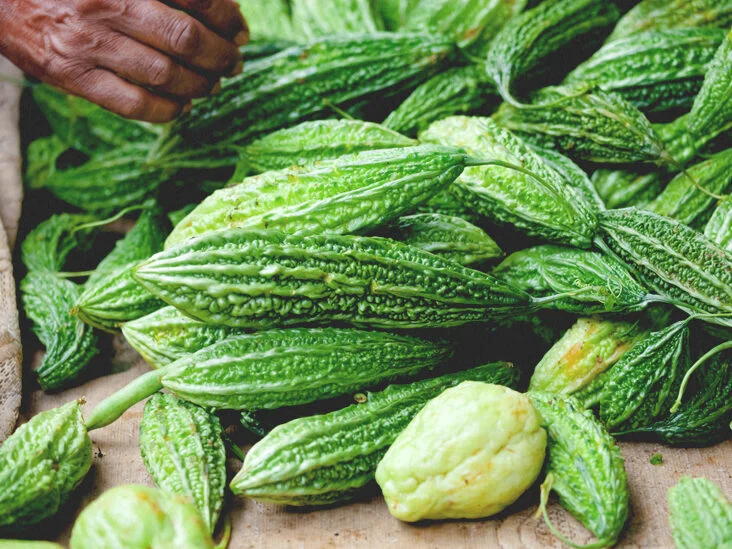Bitter gourd, scientifically known as Momorica charantia, is a unique and distinctive vegetable that is cherished for its potent medicinal properties.

Bitter gourd, scientifically known as Momorica charantia, is a unique and distinctive vegetable that is cherished for its potent medicinal properties.
Despite its bitter taste, this remarkable plant has been an integral part of traditional medicine systems in many cultures for centuries.
With its numerous health benefits and rich nutritional profile, bitter gourd continues to gain recognition and popularity in the modern world. In this article, we will explore the health benefits of bitter gourd and shed light on why this bitter elixir should not be overlooked.
Production technologies:
Bitter gourd is a direct-sown vegetable, but a polythene bag nursery is more advantageous to get early marketing and to avoid more gap filling. Use 200-gauge poly bags of 10 cm diameter by 10 cm height for sowing the seeds. Transplant 15-day-old seedlings to the main field.
- Rainfall: If cultivated in too wet conditions, bacterial and fungal wilt and fruit cracking can become major problems, resulting in a lower percentage of high-quality fruits and a shortened shelf life of the fruits.
- Temperature: Daytime temperatures between 24-27 C (75-80 F) are ideal.
- Soil: Deep, well-drained sandy loam or silt loam soils with a high organic matter content and water-retaining capacity
- In the tropics, bitter gourd can be planted year-round, although irrigation may be needed during the dry season. The crop is reportedly day neutral.
- Many farmers grow the crop in the cool and dry season, which may give good results. Still, bitter gourds are not easy to grow. Many farmers use mulch to keep soil moisture levels balanced. It demonstrates day-neutral characteristics. Like other cucurbits, this one must grow in a frost-free area, such as tropical lowlands.
- Seeds soaked in water will germinate sooner. Since this is a very fast-growing vine, producing many fruits that will rot on moist soil, trellising will reduce diseases and make harvesting easier. When the vine reaches the top of its trellis, it is recommended that all lateral branches from the soil up to the 10th node as well as the growing tip of the vine be cut off, as this will stimulate the upper branches and produce a higher yield.
Floral structure:
The flowers are solitary, unisexual, borne at leaf axils, regular, pentamerous, up to 2 cm long, and pale yellow to orange-yellow; male and female flowers are distinct. It is a luscious, climbing vine with slightly fuzzy stems clothed with dark green, deeply lobed leaves and yellow, dioecious flowers.
The important bitter gourd-growing states are Maharashtra, Gujarat, Rajasthan, Punjab, Tamil Nadu, Kerala, Karnataka, Andhra Pradesh, West Bengal, Odisha, Assam, Uttar Pradesh, and Bihar.
Why bitter guard is bitter:
The Cucurbitaceae family, of which bottle gourd is a member, contains toxic tetracyclic triterpenoid compounds called cucurbitacins, which are responsible for the bitter taste. There is no known antidote for this toxicity, and clinicians treat such cases symptomatically only.
Benefits of the bitter guard :
Bitter melon may taste bitter but is rich in fibre and various micronutrients that possess numerous health benefits, including:
- Bitter gourd is a rich source of vitamin C, which helps fight many diseases and wound healing and is crucial for development and growth.
- Vitamin A and beta-carotene present in bitter gourd are beneficial for our eyes’ health and improve vision. They are also effective for treating dark circles.
- Bitter gourd reduces several blood-sugar control markers, including haemoglobin A1c and fructosamine.
- Bitter gourd is low in calories and high in fibre, which helps decrease body weight.
- Vitamins folate, zinc, iron, and potassium are present in the bitter gourd and are essential during neural growth and development in a foetus.
- Bitter melon contains numerous powerful antioxidants, including catechin, epicatechin, chlorogenic acid, and gallic acid. These antioxidants help fight against radicals. They protect us from many diseases caused by oxidative damage, including cancer, ageing, heart diseases, and chronic conditions.
- Vitamin C, zinc, and protein components of bitter gourd promote hair growth and add shine to hair.
- Potassium, magnesium, and calcium in bitter melon reduce bad cholesterol (LDL cholesterol) levels in our blood and maintain good cholesterol (HDL) levels. Cholesterol is one of the leading causes of many heart conditions, so bitter gourd improves heart health.
- Bitter gourd has antioxidant and antimicrobial properties, which help excrete toxins from our blood and liver and heal many liver conditions.
- Regular consumption of bitter melon improves our gut health and treats many intestinal conditions, including constipation and irritable bowel syndrome (IBS).
- This bitter vegetable improves our immune system and respiratory health.
Conclusion:
Bitter gourd (Momordica charantia) is an important vegetable crop and is grown for its immature tuberculate fruits, which have a unique bitter taste. Fruits are considered a rich source of vitamins and minerals, with 88 mg of vitamin C per 100 g. Fruits are used after cooking, and delicious preparations are made.